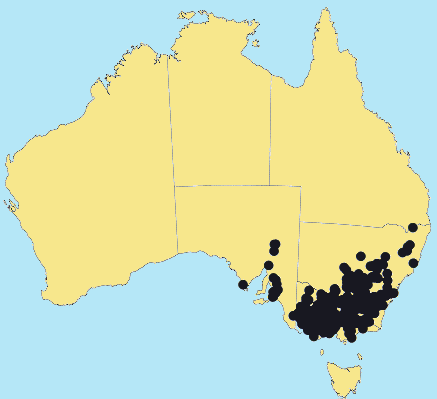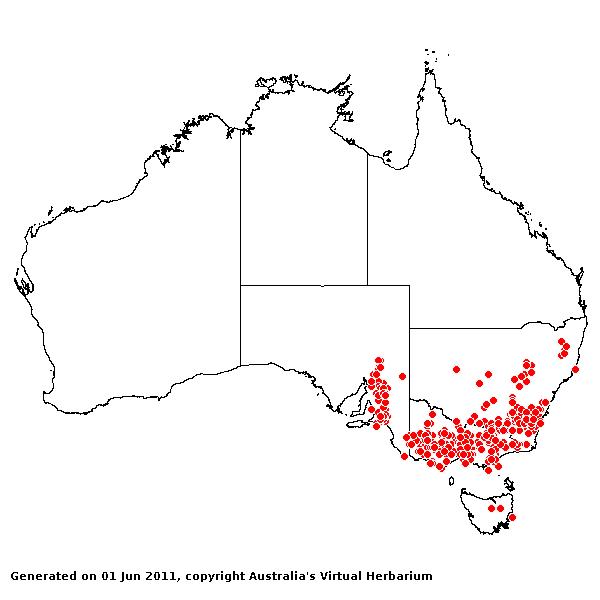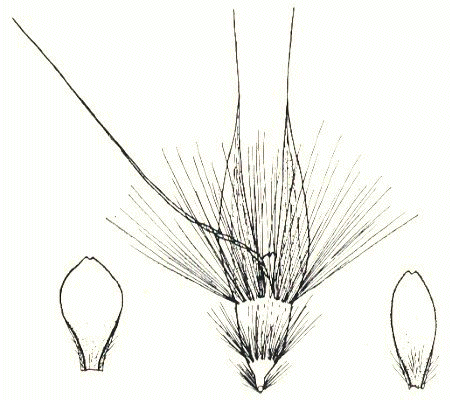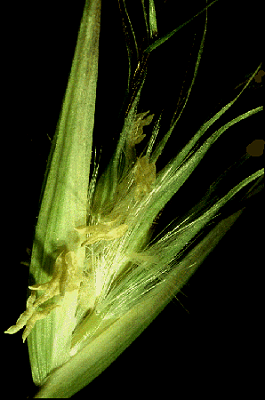Rytidosperma erianthum (Lindl.) Connor
& Edgar. New Zealand J. Bot. 17: 323 (1979).
Classification. (GPWG 2001) : Subfamily Danthonioideae. Tribe
Danthonieae.
Basionym and/or
Replacement Name: Danthonia
eriantha Lindl., Three Exped. Australia 2: 304 (1838).
Type of Basionym or
Protologue Information: HT: Mitchell s.n., Australia: interior of
New Holland, Major Mitchell's Expedition 1836, ex herb. Lindley (CGE(fragm.,
NSW-6960)).
Recent synonyms:
Notodanthonia eriantha (Lindl.) Veldkamp, Austrodanthonia eriantha (Lindl.)
H.P. Linder.
Key references
(books and floras): [2002] D.Sharp & B.K.Simon, AusGrass, Grasses of
Australia, [2006] J.Jessop, G.R.M.Dashorst, F.M.James, Grasses of South
Australia (290), [2008] S.W.L.Jacobs, R.D.B.Walley & D.J.B.Wheeler, Grasses
of New South Wales (143).
Illustrations:
[2005] K.Mallet (ed.), Flora of Australia 44B: Poaceae 3 (Fig.
11, G-H), [2006] J.Jessop, G.R.M.Dashorst, F.M.James, Grasses of South
Australia (291, fig. 225).
Derivation: Gk.
erion, wool; anthos, flower. With woolly glumes, lemmas or awns.
Habit.
Perennial. Culms erect, 19–70 cm tall, 3 -noded. Mid-culm nodes glabrous.
Leaf-sheaths hairy. Ligule a fringe of hairs. Leaf-blades filiform, involute,
10–25 cm long, 1–2 mm wide.
Inflorescence.
Inflorescence solid, a panicle. Panicle lanceolate or ovate, 2–7 cm long.
Spikelets.
Spikelets pedicelled. Fertile spikelets many flowered, with at least 2 fertile
florets (4–7), comprising 4–7 fertile floret(s), with diminished florets at the
apex, cuneate, laterally compressed, 11–18 mm long.
Glumes. Glumes
similar, thinner than fertile lemma. Lower glume lanceolate, membranous, much
thinner on margins, without keels, 11–13 -nerved. Upper glume lanceolate, 11–16
mm long, membranous, without keels, 11–13 -nerved.
Florets.
Fertile lemma 2.5–4 mm long, without keel, 9 -nerved. Lemma apex lobed, awned,
3 -awned. Median (principal) awn from a sinus, 13–15 mm long overall, with a
twisted column. Lateral lemma awns present. Lodicules present. Anthers 3. Grain
1.6–2 mm long.
Continental
Distribution: Australasia.
Australian
Distribution: South Australia, New South Wales, Victoria.
South Australia:
Flinders Ranges, Eyre Peninsula, Northern Lofty, Murray, Southern Lofty,
South-eastern. New South Wales: Central Coast, Northern Tablelands,
Central Tablelands, Southern Tablelands, North-Western Slopes, Central-Western
Slopes, South-Western Slopes, North-Western Plains, South-Western Plains. Victoria:
East Gippsland, Eastern Highlands, Gippsland Plain, Grampians, Lowan Mallee,
Midlands, Murray Mallee, Otway Plain, Riverina, Snowfields, Volcanic Plain,
Wannon, Wimmera.
Notes. Distinct
from R. caespitosum by the ovate, broad palea and the generally broader
spikelets, the smaller number of spikelets, and by the inflorescence becoming
quite compact as the seed ripens. There is a series of collections from the SW
slopes (e.g. Dwyer in NSW 153311; Beauglehole 29668), from Temora
to the Grampians, which superficially look like A. auriculata, with
subcapitate inflorescences, broad florets, dense and long upper lemma hairs,
but they lack the lemma auriculi and have glabrous palea backs, and the awns
are twice as long as the lemma setae. They are included in R. erianthum,
although they could be separated from this species and placed closer to D.
auriculatum.
Common
in south-eastern Australia, from the Queensland border to Adelaide, altitude 300–1000
m, often the dominant grass in the Southern Tablelands, replacing A.
caespitosa from the lower areas, especially common on road verges. Flowers
Oct. to Dec.







